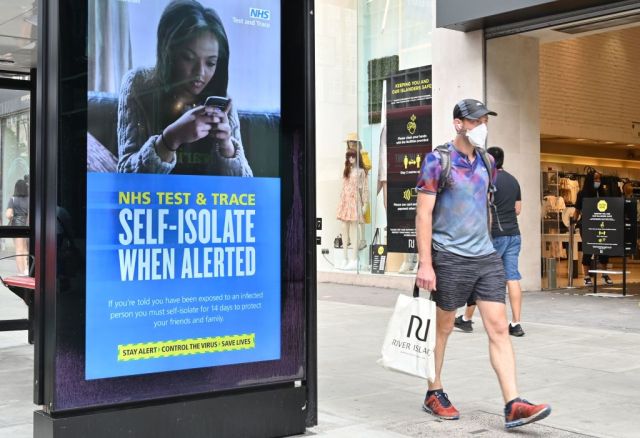If you can’t trust the British Government to organise a hugely complicated IT project, who can you? Photo by GLYN KIRK/AFP via Getty Images

Lockdown isn’t over. Nowhere near. You can’t go and sit in a pub; hardly any children are back at school; and there are still severe restrictions on who you can meet and when. Most people are still complying with those rules.
But we do need to start coming out of it soon, or the cure will become worse than the disease. So we need a way of returning to a sort of normality, and allowing the economy to restart, while avoiding that second wave.
“Test, trace and isolate” — finding infected people, tracking down the people they’ve been in contact with, and getting them all to isolate for a period — is the most promising avenue, and the government says that it has put in place a “world-beating” system. But their handling of the testing regime — full of self-congratulatory bluster and statistical malfeasance — has not instilled confidence; and while the first tranche of results from the system have been reasonably promising, it has been slow to be developed at all, so it is already fighting uphill. So: can it work?
Well, one interesting paper just published by researchers at University College London looks at the impact contact tracing will have on the economy relative to lockdown. I spoke to one of the authors, the policy researcher David Manheim, to find out whether test and trace could indeed work for the UK.
Some caveats: modelling is inherently uncertain. Manheim says that the model is robust — the headline outcomes remain broadly consistent even if the assumptions and inputs are tweaked — but it’s just one paper, and so far not peer-reviewed. As the situation develops we can compare its scenarios with reality.
It is worth noting how bad the two extreme situations, “doing nothing” and “staying locked down”, are. The most widely used estimate for the infection fatality rate (IFR) of Covid-19 is about 1%, and that’s what the paper uses. (UnHerd has spoken to various people who think it’s lower than that, and I perhaps over-optimistically predicted a few weeks ago that it would be below that level, but that seems to be the standard estimate.)
So here’s the background situation. If we come out of lockdown entirely, without any attempt at tracing and isolation, the paper estimates that between 60% and 80% of the country would end up infected, and between about 250,000 and 550,000 people would die. People will correctly point out the average age of death is over 80, but nonetheless it is a brutal toll.
On the other hand, if we try to reduce spread by only using lockdown, with no testing or tracing, then “we are likely to need lockdown for three of every four months (or four of every six months)” until the development and availability of a vaccine or highly effective drug treatments. That represents an extraordinary hit to the economy — in the worst case, around £1.2 trillion GDP lost by May 2022, when their models ended. To put that in context, the UK’s GDP in 2019 was about £2.2 trillion. We are talking about roughly a quarter of the entire UK economy being mothballed, with all the knock-on effects to health, wellbeing and happiness that entails.
What you need is some sort of way of targeting your interventions. “Think of it as a continuum,” he says. “How good is our ability to figure out if someone has Covid? If we have no ability, then it’s ‘shut everything down’. If we have some ability, then you can isolate people purely based on symptoms. That reduces spread significantly, but isn’t enough on its own.”
“If you add testing, it gets better, because testing has a lower false negative rate than symptoms, and it catches it little earlier. But tracing catches it much earlier: you isolate everyone who was in contact with this person for two weeks.”
What testing and contact tracing allows is for people to go about their lives in some fairly normal way, and for something like a fully functioning economy to get underway. But the question is whether the scale of the system needed to do that is 1) plausible and 2) available at a cost worth paying. If it would cost a trillion pounds to put one in place, then it wouldn’t really achieve anything over remaining in intermittent lockdown.
“What we model in the paper is: how many tracers would you need?” says Manheim. It’s not a small job: the paper assumes that it would take almost exactly a full week’s work (37 hours) for one contact tracer to follow up all the contacts of a single infected person, including interviews with the subject and their contacts, arranging testing, and doing follow-up monitoring calls.
Still, the basic result, he says, is that when case counts are relatively low, it is possible to identify and track enough of them to keep the rate of transmission down, at a cost that is relatively manageable. But “when there are too many cases, the costs of tracing are completely out of hand”, he says. If you have millions of cases, then you need many millions of tracers, and it becomes implausible.
Eventually it becomes cheaper simply to test literally everybody once a week — which ends up being about 10 million people a day — and requiring people who get positive tests to self-isolate. And even that is cheaper and more manageable than the costs of lockdown — the paper estimates it would cost about £36 billion over the next two years to do that many tests, a fraction of the £700 billion hit to GDP (and the smaller but still huge hit to the public finances) that we would otherwise be facing.
Luckily, the UK is not in that situation. Despite the somewhat doom-and-gloomy atmosphere, case counts are down somewhere a bit more manageable. The paper includes several scenarios which loosen and re-impose lockdown on given “triggers” — when the number of daily cases goes above 40,000, it is reimposed, and when they fall below 10,000 it is relaxed. The daily number of lab-confirmed cases in the UK, as of Sunday 14 June, was 1,514; that’s probably a low number because the weekend interferes with data collection, but data from the KCL/Zoe Covid-tracker app suggests that there are fewer than 5,000 daily new cases at the moment. So we are in the “manageable with contact tracing” zone.
But is the testing and contact tracing system we actually have fit for purpose? The British government has been making very loud noises about meeting the targets it set itself, of 100,000 tests by the end of April and 200,000 by the end of May. But those numbers were largely nonsense: the 100,000 tests included tests put in the post but not carried out, and multiple tests being carried out on the same person; the 200,000 included those but also included antibody tests, which are good and important things but entirely different. (And both also referred to “capacity”, rather than actual tests carried out.) Radio 4’s magnificent More or Less team have been digging away at this dispiriting little bit of governmental misinformation for weeks. Sadly, the virus does not seem to be reading the Department for Health and Social Care’s press releases.
The actual, real number of individual people being tested is about 50,000 a day. That’s not negligible, but in the paper’s best-case scenario (which still involves many thousands more people dying than have already), we will need to test at least 75,000 people now, and about 300,000 people a day over the winter. That’s assuming that we have enough contact tracers in place – if I’m reading the paper right, somewhere around 80,000 “public health community officers”, ie recruits, and a smaller number of more senior people to manage them – to contact all the contacts of each person with a positive test result.
The system doesn’t have to be perfect. The paper assumes that 64% of the contacts are traced within a day, and then self-isolate; but there’s no guarantee they will do so; in Israel, where Manheim lives, there are legal sanctions — people who leave their home when expected to isolate are texted a warning and can be given a ticket or arrested — but that may not be feasible here.
And, Manheim points out, we shouldn’t throw up our hands and say that the British Government’s difficulties with testing and tracing now mean that the whole enterprise is doomed: we can improve it. “The sooner we find out what does and doesn’t work, the better. You’re not going to have a perfect system on day one.” There have been reports of the contact tracers saying that they have signed up and not been given any work, which sounds bad, but “that’s like any new for-profit company building a new thing. The public sector isn’t going to magically do any better. The question isn’t whether it’s doing well on day one, but whether it’s doing OK on day 30, and doing well enough on day 60.”
That said, the Government has not covered itself in glory. “One big bottom line thing that I think is important is that this study should never have been needed,” says Manheim. “We’ve known we needed test-and-trace for a long time.” They wrote it with the intention of showing policymakers what may and may not work. It may be, he says, that in two months we learn that the Governments’ systems that they already have in place could be scaled up fast, and will do the job. But even if they aren’t, it’s better to start now than to leave it.
“What they absolutely can’t do, and is a danger in the interim, is print out giant ‘mission accomplished’ banners and declare they’ve got everything done.” It’s not easy for politicians to tell the population that we’re going to have a tough time for the next two years; you don’t get rewarded for that. So it’s easier, in the short term, to declare victory.
But in the end, the numbers of deaths and hospitalisations will be the yardstick of success, and they’re very hard to explain away. The temptation to soft-pedal, to pay lip service to test-and-trace but actually just quietly let lockdown dissolve, will be great, but then we could end up in the worst of all worlds — a huge economic hit due to the pointless 12 weeks of lockdown, and vast numbers of dead all the same.










Join the discussion
Join like minded readers that support our journalism by becoming a paid subscriber
To join the discussion in the comments, become a paid subscriber.
Join like minded readers that support our journalism, read unlimited articles and enjoy other subscriber-only benefits.
Subscribe